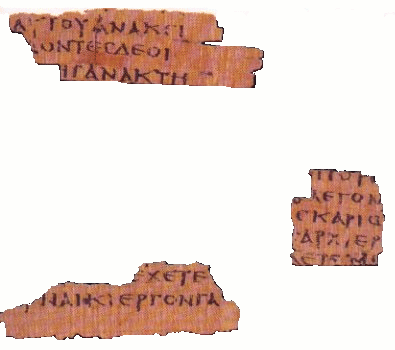Magdalen papyrus
The "Magdalen" papyrus was purchased in Luxor, Egypt in 1901 by Reverend Charles Bousfield Huleatt (1863-1908), who identified the Greek fragments as portions of the Gospel of Matthew (Chapter 26:23 and 31) and presented them to Magdalen College, Oxford, where they are cataloged as P. Magdalen Greek 17 and whence they have their name. When the fragments were finally published by Colin H. Roberts in 1953, illustrated with a photograph, the hand was characterized as "an early predecessor of the so-called 'Biblical Uncial'" which began to emerge towards the end of the 2nd century. The uncial style is epitomised by the later biblical Codex Vaticanus and Codex Sinaiticus. Comparative paleographical analysis has remained the methodological key for dating the manuscript: the consensus is, ca AD 200.
The fragments are written on both sides, conclusive proof that they came from a codex rather than a scroll. More fragments, published in 1956 by Ramon Roca-Puig, cataloged as P. Barc. Inv. 1, were determined by Roca-Puig and Roberts to come from the same codex as the Magdalen fragements, a view which has remained the scholarly consensus.
Some scholars and religious people claim the fragments are of varying age, the most early of which is the last third of the first century, but this is by no means the standard consensus. The papyrus is most likely from the second or early third century.
This site costs a lot of money in bandwidth and resources. We are glad to bring it to you free, but would you consider helping support our site by making a donation? Any amount would go a long way towards helping us continue to provide this useful service to the community.
Click on the Paypal button below to donate. Your support is most appreciated! |
|---|



